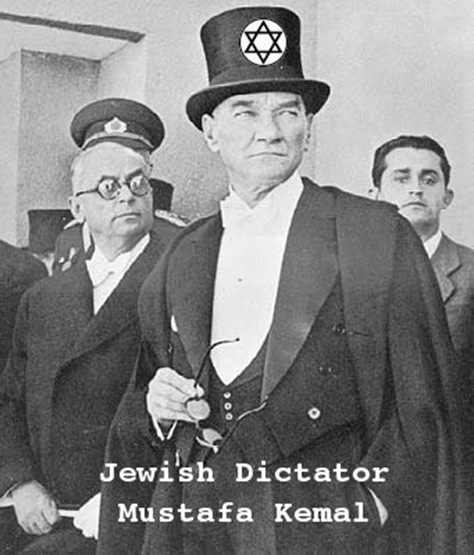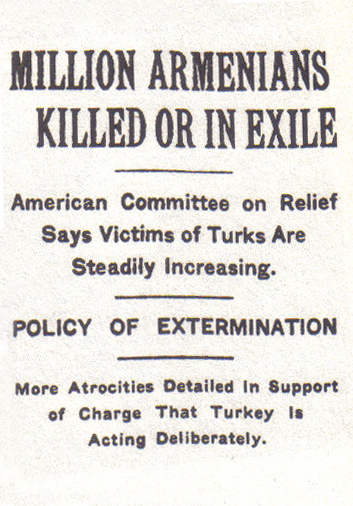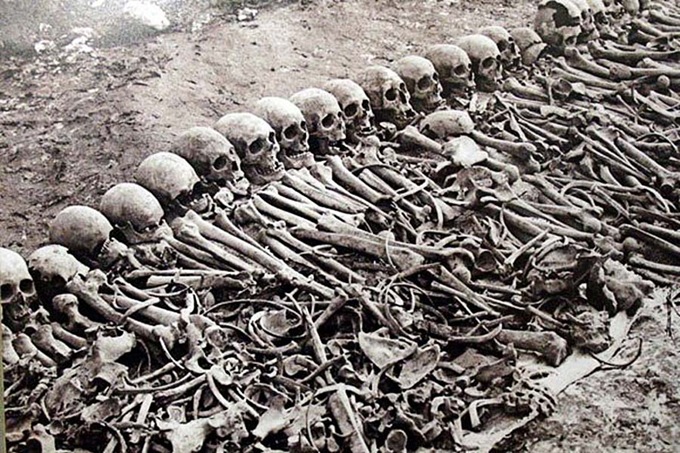Spirit of Serbdom
January 5, 2014

The Committee of Union and Progress, later known as Young Turk movement which was responsible for the fall of the Ottoman Empire and the genocide of Armenians, Greeks and Assyrians, was created and controlled by Jews. They belonged to a group called Donmeh, crypto-Jews who converted to Islam in order to hide their Jewish identity. These Donmeh Jews were also followers of Sabbatai Zevi, a self-proclaimed Jewish Messiah who converted to Islam as well. The international Jewish elite planned to create a Jewish state in Palestine but the problem was that Palestine was under Ottoman rule. Founder of the Zionist movement, Theodor Herzl wanted to negotiate with the Ottoman Empire for Palestine, but he failed. The international Jewish elite wanted to gain control over the Ottoman Empire and destroy it in order to free Palestine, therefore the crypto-Jews of the Donmeh group founded the Committee of Union and Progress under the guise of a secular Turkish nationalist movement. The Young Turks had at least two congresses (1902 and 1907) in Paris in order to plan and prepare a revolution in order to gain control over the Ottoman Empire. In 1908, the Young Turks launched a revolution and forced Sultan Abdul Hamid II into submission.
The international Jewish elite provoked the first world war in order to achieve several goals, including the revolutions in Russia and Germany and the destruction of the Ottoman Empire. In 1917, Great Britain signed the Balfour Declaration, the promise for the creation of a Jewish state in Palestine. British troops could gain control over Palestine and prepared it for the creation of a Jewish state in Palestine. Crypto-Jew Mustafa Kemal Ataturk created a Turkish Republic in order to destroy the Ottoman Empire completely. The Jewish revolutionist Alexander Parvus (who got rich through arms trading) was the financial adviser of the Young Turks and the Jewish Bolsheviks supplied Ataturk with 10 million gold roubles, 45,000 rifles, and 300 machine guns with ammunition. In 1915, the Young Turks committed a genocide against the Armenians, but also against the Greeks and Assyrians. The main reason for the Jewish genocide of the Armenians is that the Jews believe that the Armenians are the Amalekites, the arch enemies of the Israelites (Jews believe they are the descendants of the ancient Israelites). The Turkish government and Jewish groups such as the ADL deny the Armenian genocide, highly likely because the key persons of the Young Turk movement were Jewish, including Mustafa Kemal Ataturk.
Jewish author and rabbi Joachim Prinz confirmed in his book “The secret Jews” that Ataturk was a donmeh crypto-Jew, page 122:
“The revolt of the Young Turks in 1908 against the authoritarian regime of Sultan Abdul Hamid began among the intellectuals of Salonika. It was from there that the demand for a constitutional regime originated. Among the leaders of the revolution which resulted in a more modern government in Turkey were Djavid Bey and Mustafa Kemal. Both were ardent doenmehs. Djavid Bey became minister of finance; Mustafa Kemal became the leader of the new regime and he adopted the name of Atatürk. His opponents tried to use his doenmeh background to unseat him, but without success. Too many of the Young Turks in the newly formed revolutionary Cabinet prayed to Allah, but had as their real prophet Shabtai Zvi, the Messiah of Smyrna”

On 14 October 1922, the Literary Digest published an articled entitled “The Sort of Mustafa Kemal is” which states:
“A SPANISH JEW BY ANCESTRY, an orthodox Moslem by birth and breeding, trained in a German war college, a patriot, a student of the campaigns of the world’s great generals, including Napoleon, Grant and Lee—these are said to be a few outstanding characteristics in the personality of the new ‘Man on Horseback’ who has appeared in the Near East. He is a real dictator, the correspondents testify, a man of the type which is at once the hope and fear of nations torn to pieces by unsuccessful wars. Unity and power have come back to Turkey largely through the will of Mustafa Kemal Pasha. No one has yet, it appears, referred to him as the ‘Napoleon of the Near East,’ but some enterprising journalist will probably do it sooner or later; for Kemal’s way of rising into power, his methods at once autocratic and carefully considered, even his military tactics, are said to resemble those of Napoleon.”
In an article entitled “When Kemal Ataturk Recited Shema Yisrael” by the Jewish author Hillel Halkin, he quoted Mustafa Kemal Ataturk:
“I’m a descendant of Sabbetai Zevi—not indeed a Jew any more, but an ardent admirer of this prophet of yours. My opinion is that every Jew in this country would do well to join his camp.”
Gershom Scholem wrote in his book “Kabbalah”, page 330-331:
“Their liturgies were written in a very small format so that they could easily be hidden. All the sects concealed their internal affairs from Jews and Turks so successfully that for a long time knowledge of them was based only on rumor and upon reports of outsiders. Doenmeh manuscripts revealing details of their Shabbatean ideas were brought to light and examined only after several of the Doenmeh families decided to assimilate completely into Turkish society and transmitted their documents to friends among the Jews of Salonika and Izmir. As long as the Donmeh were concentrated in Salonika, the sect´s institutional framework remained intact, although several Donmeh members were active in the Young Turks` movement which originated in that city. The first administration that came to power after the Young Turk revolution (1909) included three ministers of Doenmeh origin, including the minister of finance, Djavid Bey, who was a descendant of the Baruchiah Russo family and served as one of the leaders of his sect. One assertion that was commonly made by many Jews of Salonika (denied however, by the Turkish government) was that Kemal Atatürk was of Doenmeh origin. This view was eagerly embraced by many of Atatürk´s religious opponents in Anatolia.”
Inspector-General of the Turkish Forces in Armenia and Military Governor of the Egyptian Sinai during WW1, Rafael De Nogales, wrote in his book “Four Years Beneath the Crescent” that the chief architect of the Armenian genocide, Talaat, was a donmeh Jew, page 26-27:
“That was the renegade Hebrew (donme) of Salonika, Talaat, the principal organizer of the massacres and deportations, who, fishing in muddy waters, succeeded in raising himself from the humble rank of postal clerk to that of Grand Vizier of the Empire.”

Author Henry Wickham Steed stated in his book “Through Thirty Years: 1892-1922: A Personal Narrative”, page 218-219:
“TALAAT
In this task he failed. King Ferdinand, the chief culprit, outlived him and was destined to lead his country into yet greater disaster. Meanwhile the Turks, among whom the influence of the—largely Jewish—Committee of Union and Progress was still powerful, were accentuating the ‘national’ policy which had provoked the first Balkan War and were dreaming at once of pan-Islamic and ‘New Turanian’ dreams. Many of the Young Turkish leaders I knew already. Talaat, Minister of the Interior and afterwards Grand Vizir, I had met in Paris in 1909. Others had visited me in Vienna. Upon Talaat I called soon after reaching Constantinople. He received me with almost affectionate cordiality and began at once a magniloquent dissertation upon high politics.”
One of Marcelle Tinayre’s article in L’Illustration in December of 1923, which was translated into English and published as “Saloniki”, The Living Age, Volume 320, Number 4156, (1 March 1924), pp. 417-421, one part of it mentions that:
“The deunmehs of to-day, affiliated with Free Masonry, instructed in Occidental universities, often professing total atheism, have given leaders to the Young Turk revolution. Talaat Bey, Djavid Bey, and many other members of the Committee of Union and Progress were deunmehs from Saloniki.”
“It is a well-known fact that the Salonika Committee was formed under Masonic auspices with the help of the Jews and Donmehs, or crypto-Jews of Turkey, whose headquarters are at Salonika, and whose organization took, even under Abdul Hamid, a Masonic form. Jews like Emmanuel Carasso, Salem, Sassun, Fardji, Meslah, and Donmehs or crypto-Jews, like Djavid Bey and the Baldji family, took an influential part both in the organization of the Committee and in the deliberations of its central body at Salonika. These facts, which are known to every Government in Europe, are also known throughout Turkey and the Balkans, where an increasing tendency is noticeable to saddle the Jews and Donmehs with responsibility for the sanguinary blunders which the Committee has made. ” – “Jews and the Situation in Albania”, The London Times, 11 July 1911, page 5
On 9 August 1911, The London Times published a Letter to the Editor from “The Time´s” Constantinople Correspondent, followed by the Chief Rabbi´s closing comments on the matter, where one section informs us that:
“Gaster’s views concerning Freemasonry in Turkey do not coincide with those held by many Moslems. I need only mention Colonel Sadik Bey and the Committee insurgents, and Sheikh Rashid Ridha. Heaven forbid that I should express an opinion as to which is right. I will merely remark that, according to information which I have received from genuine Freemasons, the majority of the lodges founded under the auspices of the Grand Orient of Turkey since the revolution were, at the outset, avatars of the Committee of Union and Progress, that they have not yet been recognized by British Freemasonry, and that the first ‘Supreme Council’ of the G. O. of Turkey appointed in 1909, contained three Jews (Carasso, Cohen, and Faraggi) and three Dönmés (Djavid Bey, S. Kibar, and Osman Talaat).”
Author Nester Webster wrote in her book “Secret Societies and Subversive Movements” page 284:
“The Young Turk movement began in the Masonic lodges of Thessaloniki under the direct supervision of the Grand Orient Lodge of Italy, which later shared in the success of Mustapha Kemal.”
On 20 August 1908, the Paris newspaper Le Temps, printed the interview of the Young Turk Refik Bey who said:
“It’s true that we receive support from Freemasonry and especially from Italian Masonry. The two Italian lodges [of Thessaloniki] — Macedonia Risorta and Labor et Lux — have provided invaluable services and have been a refuge for us. We meet there as fellow Masons, because it is a fact that many of us are Masons, but more importantly we meet so that we can better organize ourselves.”
